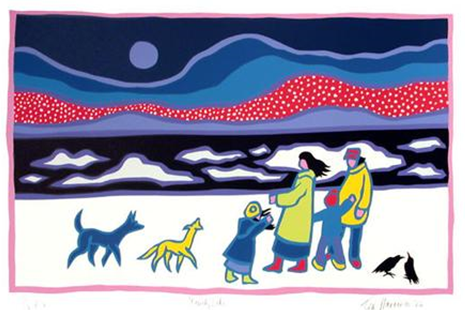5.4: Writing Skills- The Descriptive Paragraph
- Page ID
- 104419

Ted Harrison (1926−2015) was one of Canada’s best-loved painters. Born in England, he taught art in many countries before settling with his family in Carcross, Yukon. His paintings focus on the colours and culture of northern Canada.
What Is a Descriptive Paragraph?
A paragraph in which you write about the appearance of a person, place, thing, or event. A descriptive paragraph answers the question “What is it like?” In this paragraph, a painting by artist Ted Harrison is described and interpreted.
Family Lake, painted by Ted Harrison in 1986, is characteristic of the artist’s bold, colourful style. This painting shows a family (mother, father, two children, and two dogs) in the forefront. They are standing beside an ice-cold lake with mountains in the background. They are standing on snow, and ice floes float in the dark water. Ted Harrison has chosen to use bright, clear colours in his painting. The mother, for example, is wearing a green coat, a blue skirt, and red boots; her husband is dressed in a yellow coat and pink hat. The colours used to portray the natural environment are not realistic: the sky is black, the sun is purple, and the mountains are shades of red, blue, and purple. The family dogs are blue and yellow. There is a sense of childishness and innocence in the artist’s choice of colours. Despite its simplicity and bright colours, however, the picture conveys a sense of isolation and bleakness. The black lake is deep and unforgiving. There are no buildings in sight, no other people. There is a feeling of unease here. The two children are not playing in the snow; rather, they lift their arms up to their parents, looking for comfort. The mother’s long hair blows in the wind, and she is not wearing a hat. You can feel how cold it is in the picture, and how harsh their living conditions are. Two black birds, perhaps crows, stand ominously on the snow, next to the family. This is, therefore, a deceptively simple painting with a deeper meaning.
What Makes a Good Descriptive Paragraph?
- It gives both a general overview and specific details. You need to set the scene—what the paragraph is about—but it is also important to be specific. If you write about a woman, for example, by saying “She is pretty,” that does not tell your reader anything about what she looks like. In the same way, if you say about a place, “It is beautiful,” your reader is no wiser about what you can see in the view. It is important to show your reader what something looks like, not ask your reader to guess. Create a picture in the mind of the reader.
- It appeals to the five senses: sight, sound, smell, taste, and touch. For example, if you are describing a meal, have you used words to show what the food tastes like? If you are describing a winter scene, have you written in such a way that the reader feels cold? If you are describing a marketplace, have you described the sounds you can hear, or the smells in the air?
- It appeals to the emotions. A good descriptive paragraph suggests the mood created by the person or place. Does it give a happy feeling, or does it convey negative emotions?
Steps for Writing the Descriptive Paragraph
1. As always, your writing should begin with some brainstorming. Think about the person, place, or thing that you want to describe—what do you want to say about it? Use a mind map to start to collect some ideas.
2. Make a plan for your paragraph.
3. Write your first draft. Don’t worry about getting everything perfect at this stage; just get your ideas on paper.
4. Revise your draft. Follow the ARMS checklist you learned in Unit 1 (Add, Remove, Move, and Substitute). Make sure your writing answers the following questions:
- Have you given enough details? Have you created a picture in the mind of your reader?
- Which senses have you appealed to?
- Have you appealed to the emotions?
5. Edit your paragraph and write your final draft. Now that your ideas are in place, you can focus on grammar, spelling, word choice, and punctuation.
You Try It!
Look at the following pictures. Imagine you are in this place. Describe what you can see, hear, smell, taste, and touch around you.
Picture 1

________________________________________________________________________
________________________________________________________________________
________________________________________________________________________
________________________________________________________________________
________________________________________________________________________
________________________________________________________________________
________________________________________________________________________
________________________________________________________________________
________________________________________________________________________
Picture 2

________________________________________________________________________
________________________________________________________________________
________________________________________________________________________
________________________________________________________________________
________________________________________________________________________
________________________________________________________________________
________________________________________________________________________
________________________________________________________________________
________________________________________________________________________
Picture 3

________________________________________________________________________
________________________________________________________________________
________________________________________________________________________
________________________________________________________________________
________________________________________________________________________
________________________________________________________________________
________________________________________________________________________
________________________________________________________________________
________________________________________________________________________
In Bring It Together: Writing Task you will write a paragraph describing a photograph you have taken. Use what you have learned in this section to help you.

